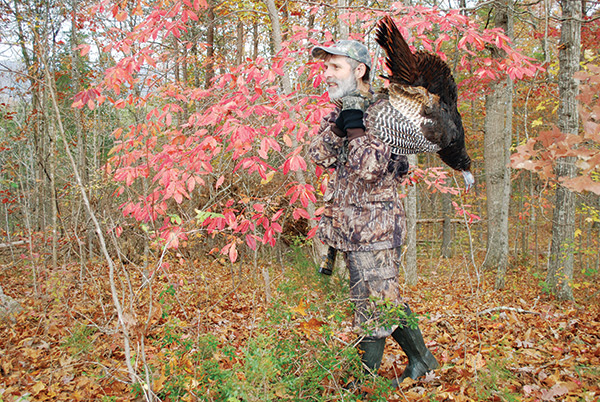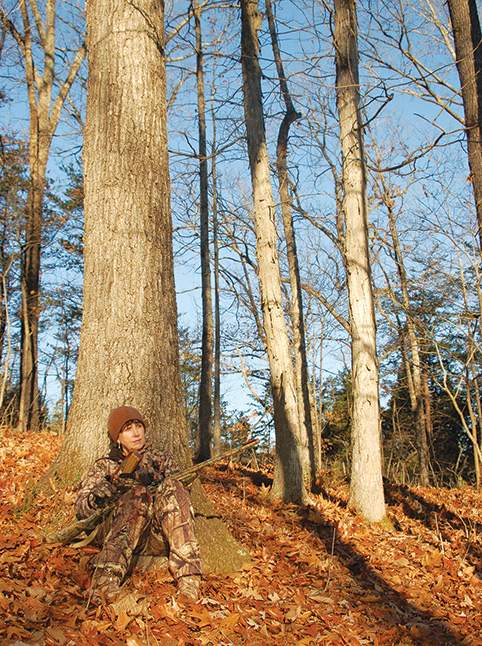 Hunting: Fall Turkey
Hunting: Fall Turkey
By Bruce Ingram

I enjoy hunting deer, but turkey’s my favorite game. When a flock meanders by my deer stand, I switch gears in a hurry. Even if deer is your top priority, there is no reason not to take advantage should similar opportunity come your way.
A number of years ago I was posted up on a Virginia mountainside hunting deer with a muzzleloader. The rut was just beginning, and I had high hopes. Yet I didn’t see anything of note until a gang of turkeys ambled by at around 3 in the afternoon. I had a tag and could have legally shot one with the smoke pole, but I wasn’t sure I could hit a tiny bobbing head, and I didn’t want to ruin the best meat by plowing a .50 slug through the breast. Instead, I quickly laid down the muzzleloader and charged right into the gang, screaming and waving my arms like a lunatic.
The bust was perfect as flock members dispersed in every direction. Then I ran back to the stand, grabbed my rifle and scudded 200 yards downslope to where my vehicle was parked off the side of the woods road. I swapped the muzzleloader for a 12-gauge. Yes, it is legal in the Old Dominion to carry both a shotgun and a smoke pole during early muzzleloader season.
I climbed back up to where I had scattered the assemblage and set up. The switch had taken 10 minutes, and, generally, young fall turkeys take at least 15 minutes to begin calling to one another in order to reassemble the flock. Sometimes they wait two hours or more.
I popped in a diaphragm call and began making the kee-kees and kee-kee runs that young jakes and jennies also emit. Not long afterwards, several young jennies responded, and when three of them walked up the mountainside toward me, I took the lead bird. After taking bird and shotgun back to the car, I resumed deer hunting.
Wish I could say I also tagged a deer that day. I can’t, but I can say my wife, Elaine, and I dined on wild turkey breast for Thanksgiving. When hunting deer or any other game during fall turkey season, if it is allowed, why not stash a shotgun in the vehicle?
The percentage play with fall turkeys—especially a flock consisting of a mature hen, her jakes and jennies—is to scatter the group if you can. Young turkeys are much easier to call in if they have been separated from a busted flock, and they usually afford enough time to go get the shotgun and get set up for their return.
But don’t attempt to bust a flock that is more than 50 yards or so away. Humans can’t outrun let alone outfly wild turkeys. A charge from too far away will result in the birds flying off together, and that accomplishes nothing besides alerting the birds that a two-legged predator is prowling the woods.
If the birds are uphill from you, don’t even consider a scatter. Running uphill after turkeys is sheer folly.
Let an uphill flock move out of sight. Then get your shotgun and quietly maneuver above them, using the terrain to shield yourself from keen eyes. Once above the turkeys, charge downhill and bust the flock.
Sometimes you have to play a longer game. After a long weekend in October looking for turkeys and not finding a single flock, I decided to instead bowhunt deer after work the next evening. Didn’t see any deer, but with half an hour of light left, I watched a flock of turkeys feeding about 75 yards from my tree stand. At twilight they flew up to roost in some hardwoods.
The stand was on an elevated flat between two steep hollows, and the west-facing hollow was where the birds had settled in for the night. I remained in the stand until well after full dark. Then I descended, laid my bow on the ground under the stand, and walked quietly to the lip of the hollow.
I turned on a flashlight and began walking about in the hollow, scattering roosted turkeys in all directions. It was an absolutely perfect bust.
The next morning I returned and set up well before sunrise. About 40 minutes before dawn, I began calling softly, ramped up my efforts about 10 minutes before dawn, and at daybreak I launched into panic-stricken kee-kees.
From all directions jakes and jennies began filling the forest with turkey talk. Twenty minutes after dawn, I was walking back to the vehicle with a jenny slung over my shoulder. The 15-yard shot couldn’t have been easier.
I had plenty of time to check the bird before work, but I had to store the young hen in the refrigerator until she could be dressed later that evening. Elaine was a little perturbed--well, maybe more than a little perturbed--to see a dead turkey in the fridge. But I made amends by giving the fridge a good cleaning before going to bed.
Turkeys like to roost in hollows, especially those with creeks running through them. If you see a flock ramble by in the evening but aren’t sure where they went to roost, wait until it is dark and check out any hardwood hollows in the vicinity. Chances are good one of them is where the gang flew up.
Hardwood hollows that have a lip or a flat above can be especially attractive. Turkeys like to walk to the edge and pitch off into the trees below.
If you still can’t find the flock, check any nearby stands of mature evergreens. Turkeys especially like to roost in evergreens when it’s windy or after a snow. Whether you’re in a hardwood hollow or evergreen glade, look for mounds of droppings on the forest floor. That’s the surest sign turkeys have been roosting in the branches overhead.
Flocks are much easier to find when acorn production has been poor. Then, it can be a relatively simple matter of locating an oak grove that has produced acorns. Finding scratchings that appear to be of various ages confirms that turkeys are frequenting such a grove.
A scratching that shows dark soil and no leaves inside a disturbance the size and shape of a washbasin indicates birds were there possibly that very day and definitely within the past 24 hours. Scratching that is several days old will typically hold a few scattered leaves, and the soil will look drier.
Old scratchings of a week or more will be mostly filled in with leaves and generally have very dry, light soil.
Do not attempt to scatter a roosted flock before total darkness falls. The worst rookie mistake I made when learning to scatter roosted flocks was being too impatient to wait until every trace of sunlight had disappeared from the night sky. If there is a glimmer of light on the horizon, scattered turkeys will all fly toward that speck of sunshine.
Once again, you have accomplished nothing by scattering them as they will be together and ignore your calls when flying down the next morning.
That said, evening busts are much more effective than morning busts. Young jakes and jennies in particular awaken the next morning in a full-blown panic, desiring above all else to be back with their flock mates. This makes them especially vulnerable to calling. Here’s the calling sequence I use:
About 40 minutes before sunrise, I begin making “putting” sounds. These are soft, barely audible clucks that all ages and sexes of turkeys make when first waking in the morning. About 25 minutes before dawn, I start uttering tree yelps, which are the same as regular yelps only much softer.
As dawn nears, I make progressively louder tree yelps. Right before dawn, I let loose with full-volume yelps. At dawn, I launch into kee-kees and kee-kee runs (kee-kees with yelps added).
If jakes are in the mix, throw in some jake gobbles, as well, and it never hurts to add some clucks and yelps, too. Young males are always looking for a fight with a fellow jake, thus the effectiveness of the jake gobble, which is not as loud nor as deep as a mature tom and sort of collapses at the end as the young bird apparently runs out of wind.
During one of the most difficult fall turkey seasons I had ever endured, I spent an entire weekend driving hundreds of miles to different farms without even hearing a turkey. With a heavy mast crop, the turkeys didn’t have to roam far for food, and they were hanging tight in the backwoods.
I was so frustrated by a Sunday afternoon in December I decided to throw it in at 2:30 and begin the 90-minute drive home. Upon arriving at the car and re-acquiring cell service, I read this text from my son-in-law David, who lives with his family on the same 38-acre parcel as Elaine and I:
“Was squirrel hunting behind house. Accidentally busted flock on way back to get boys/Sarah to go to my parents for dinner. U interested?”
You bet I was. I drove home as fast as the speed limit allowed, parked, and walked quickly into the woods behind David’s house. I set up at the first tree that was wide enough to put my back against, began making kee-kees, and shot a jenny at 3:45.
While walking over to my house to phone check and then field dress the young hen, I had an “ah ha” moment. It was perfectly possible, perhaps even likely, that not all of the flock had reassembled with darkness fast approaching.
So the next morning before work, I set up under the same tree, waited until the time was right, and began calling. I had barely started the first calling sequence when a jake gobble reverberated through the woods. I gobbled in response, and at dawn a trio of young toms sprinted toward my position. I shot the leader.
Following six weeks of no luck at all, I punched both of my fall tags in the course of 15 minutes of hunting.
I realize that most hunters would rather chase deer in the fall. Even I make time for a little deer hunting when Virginia and West Virginia fall turkey seasons are also in.
However, if I am still holding a turkey tag, you can bet there will be a shotgun stashed in the vehicle.
It’s also a good idea to pocket a couple of turkey loads when hunting squirrels, rabbits, grouse, or other game with a shotgun. When opportunity knocks, be ready to answer.
